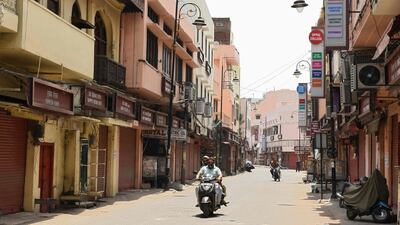India opened vaccinations to all adults on Saturday, starting an effort sure to tax the limits of the federal government, the country’s vaccine factories and patience of its 1.4 billion people.
The world’s largest vaccine maker was still short of critical supplies due to lagging manufacturing and raw material shortages that delayed the campaign in several states. Even where drugs were in stock, India’s wide economic disparities made access to the vaccine inconsistent.
The drive was also partly overshadowed by a fire in a Covid-19 hospital ward in western India on Saturday that killed 18 patients, and the death of 12 coronavirus patients at a medical facility in New Delhi that ran out of oxygen for an hour and 20 minutes.
Only a fraction of India’s population will be able to afford the vaccine, experts said, meaning states will be saddled with immunising the 600 million Indian adults younger than 45, while the federal government gives shots to 300 million healthcare and front-line workers, and people older than 45.
So far, government vaccines have been free, and private hospitals have been permitted to sell shots capped at 250 rupees ($3). That will now change. Prices for state governments and private hospitals will be determined by vaccine companies. Some states might not be able to provide vaccines for free since they are paying twice as much as the federal government for the same shot, and prices at private hospitals could rise.
Since state governments and private players compete for shots in the same marketplace, and states pay less for doses, vaccine makers can reap more profit by selling to the private sector, said Chandrakant Lahariya, a health policy expert. That cost can then be passed on to people receiving the shots, increasing inequity.
“There is no logic that two different governments should be paying two prices,” Mr Lahariya said.
Concerns that pricing issues could deepen inequities are only the most recent hitch in India’s sluggish immunisation efforts. Less than 2 per cent of the population has been fully immunised and about 10 per cent has received one dose. The average number of shots per day has dipped from more than 3.6 million in early April to less than 2.5 million.
In a positive development, India received its first batch of Sputnik V vaccines from Russia. Moscow signed a deal with an Indian pharmaceutical company to distribute 125 million doses.
Some experts warned that conducting a massive inoculation effort now could worsen the surge in a country that is second only to the US in its number of infections, at more than 19.1 million.
“There’s ample evidence that having people wait in a long, crowded, disorderly queue could itself be a source of infection,” said Dr Bharat Pankhania, a senior clinical lecturer specialising in infectious diseases at the UK's University of Exeter. He urged India to first stop the circulation of the virus by imposing “a long, sustained, strictly enforced lockdown”.














